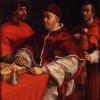Ghirlandaio, Confirmation of the Franciscan Rule (1485)
External links
Commentary
Instead of asking ‘What was Renaissance humanism?’, we might first ask, ‘What was Renaissance humanism for?’. This fresco by Domenico Ghirlandaio, part of a series of the Life of St Francis from the Sassetti Chapel in Santa Trìnita, Florence (1483-85), proposes an answer. Behind the scene of the pope’s confirmation of the Franciscan rule is depicted Florence’s Piazza della Signoria, the large square in front of the palace of the Florentine republican government. In the foreground on the right, dressed in the sober robes of mature Florentine citizens, are Ghirlandaio’s patron, the banker Francesco Sassetti, along with his young son, his brother-in-law Antonio Pucci, Standard-Bearer of Justice (in black), and Sassetti’s own political and professional patron, Lorenzo ‘the Magnificent’ de’ Medici (1449-92); in front, entering the scene from a staircase below, are the Medici children – Piero, Giuliano, and Giovanni (the future Pope Leo X) – led by their tutor, the important humanist poet and philologist Angelo Poliziano (1454-94). The message of the detail is that an education in the studia humanitatis is a preparation and even a point of entry for urban political life and participation in Florence’s office-holding class. The idea that the liberal arts were a qualification for active citizenship was an old one, given new life in the both meritocratic and elitist environment of fifteenth-century Florence. Humanist study was politically agnostic and Latin eloquence was adaptable to the needs all sorts of regime, but early Renaissance Florence is probably unique in the period in the amount of space and prestige it gave to political oratory. Within nine years of this fresco cycle’s completion, Lorenzo and Poliziano would be dead and the Medici would be ousted (for the first time). In the very different political environments of the leading centres of Italian humanism in the ensuing period – papal Rome and aristocratic, republican Venice – oratory took on a more performative function (in the former) and the urban space itself exerted a lesser influence on intellectual culture (in the latter).
Credits: Oren Margolis (July 2018)

